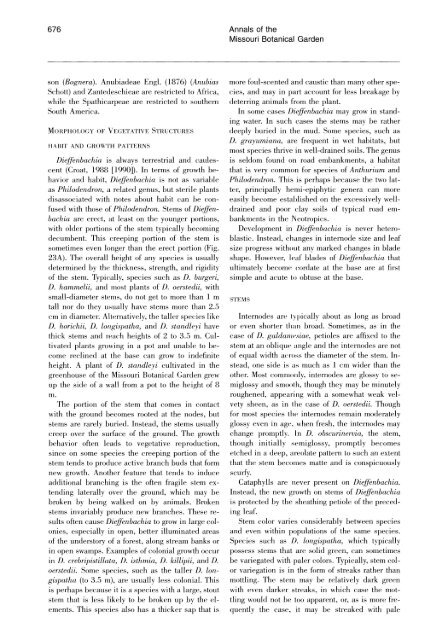l - CNCFlora
l - CNCFlora
l - CNCFlora
You also want an ePaper? Increase the reach of your titles
YUMPU automatically turns print PDFs into web optimized ePapers that Google loves.
676 Annals of the<br />
Missouri Botanical Garden<br />
son (Bognera). Anubiadeae Engl. (1876) (Anubias more foul-scented and caustic than many other spe-<br />
Schott) and Zantedeschieae are restricted to Africa, cies, and may in part account for less breakage by<br />
while the Spathicarpeae are restricted to southern deterring animals from the plant.<br />
South America.<br />
In some cases DieJ7enbachia may grow in standing<br />
water. In such cases the stems may be rather<br />
MORPHOLOGY OF VEGETATIVE STRUCTURES deeply buried in the mud. Some species, such as<br />
IIABIrF AND GROWTH PATTERNS<br />
D. grayumiana, are frequent in wet habitats, but<br />
most species thrive in well-drained soils. The genus<br />
Dieffenbachia is always terrestrial and caules- is seldom found on road embankments, a habitat<br />
cent (Croat, 1988 [1990]). In terms of growth be- that is very common for species of Anthurium and<br />
havior and habit, Dieffenbachia is not as variable Philodendron. This is perhaps because the two latas<br />
Philodendron, a related genus, but sterile plants ter, principally hemi-epiphytic genera can more<br />
disassociated with notes about habit can be con- easily become estal)lished on the excessively wellfused<br />
with those of Philodendron. Stems of Dieffen- drained and poor clay soils of typical road embachia<br />
are erect, at least on the younger portions, bankments in the Neotropics.<br />
with older portions of the stem typically becoming Development in Dieffenbachia is never heterodecumbent.<br />
This creeping portion of the stem is blastic. Instead, changes in internode size and leaf<br />
sometimes even longer than the erect portion (Fig. size progress without any marked changes in blade<br />
23A). The overall height of any species is usually shape. However, leaf blades of Dieffenbachia that<br />
determined by the thickness, strength, and rigidity ultimately become ( ordate at the base are at first<br />
of the stem. Typically, species such as D. burgeri, simple and acute to obtuse at the base.<br />
D. hammelii, and most plants of D. oerstedii, with<br />
small-diameter stems, do not get to more than 1 m<br />
tall nor do they usually have stems more than 2.5<br />
STEMS<br />
cm in diameter. Alternatively, the taller species like Internodes are ty)ically about as long as broad<br />
D. horichii, D. Ion;,Xisl)atha, and D. standleyi have or even shorter tl(l] broad. Sometimes, as in the<br />
thick stems and reach heights of 2 to 3.5 m. Cul- case of D. galdan7(.siae, petioles are affixed to the<br />
tivated plants growing in a pot and unable to be- stem at an oblique tlngle and the internodes are not<br />
come reclined at the base can grow to indefinite of equal width acloss the diameter of the stem. Inheight.<br />
A plant of D. standleyi cultivated in the stead, one side is as much as 1 cm wider than the<br />
greenhouse of the Missouri Botanical Garden grew other. Most commolllyX internodes are glossy to seup<br />
the side of a wall from a pot to the height of 8 miglossy and smooth though they may be minutely<br />
m.<br />
roughened, appearing with a somewhat weak vel-<br />
The portion of the stem that comes in contact vety sheen, as in tlle case of D. oerstedii. Though<br />
with the ground becomes rooted at the nodes, but for most species tlle internodes remain moderately<br />
stems are rarely buried. Instead, the stems usually glossy even in age, when fresh, the internodes may<br />
creep over the surface of the ground. The growth change promptly. 1 n D. obscurinervia, the stem,<br />
behavior often leads to vegetative reproduction, though initially semiglossy, promptly becomes<br />
since on some species the creeping portion of the etched in a deep, areolate pattern to such an extent<br />
stem tends to produce active branch buds that form that the stem becomes matte and is conspicuously<br />
new growth. Another feature that tends to induce scurfy.<br />
additional branching is the often fragile stem ex- Cataphylls are never present on Dieffenbachia.<br />
tending laterally over the ground, which may be Instead, the new growth on stems of Dieffenbachia<br />
broken by being walked on by animals. Broken is protected by the sheathing petiole of the precedstems<br />
invariably produce new branches. These re- ing leaf.<br />
sults often cause Dieffenbachia to grow in large col- Stem color varies considerably between species<br />
onies, especially in open, better illuminated areas and even within populations of the same species.<br />
of the understory of a forest, along stream banks or Species such as D. Iongispatha, which typically<br />
in open swamps. Examples of colonial growth occur possess stems that are solid green, can sometimes<br />
in D. crebripistillata, D. isthmia, D. killipii, and D. be variegated with paler colors. Typically, stem col-<br />
Oerstedii. Some species, such as the taller D. Ion- or variegation is in the form of streaks rather than<br />
gispatha (to 3.5 m), are usually less colonial. This mottling. The stem may be relatively dark green<br />
is perhaps because it is a species with a large, stout with even darker streaks, in which case the motstem<br />
that is less likely to be broken up by the el- tling would not be too apparent, or, as is more freements.<br />
This species also has a thicker sap that is quently the case, it may be streaked with pale

















